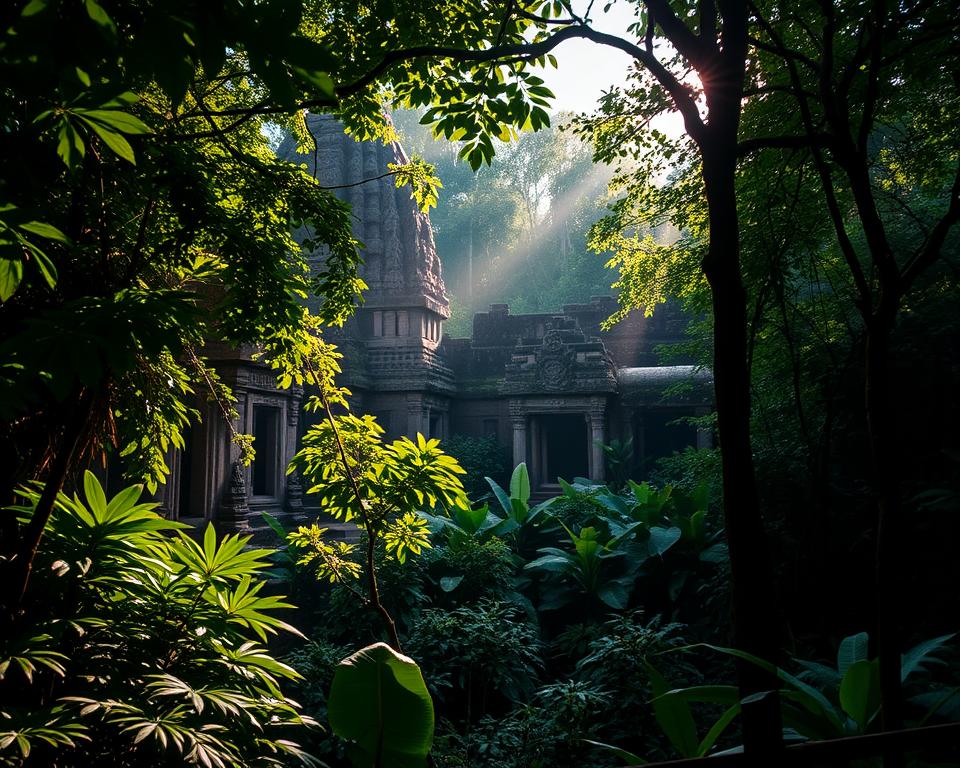
Hidden Temples in Ubud
Bali has over 20,000 temples, a lot to see1. In Ubud, there are special temples hidden from the crowds. These temples show the deep traditions and beliefs of the Balinese.
Ubud is known for its culture and art. It has temples like Pura Taman Saraswati and Pura Dalem1. The Pura Taman Saraswati is for the Goddess of knowledge and arts. It has beautiful doors and a calm place for visitors to feel Balinese spirituality1.
The Pura Dalem is close to Ubud’s main streets. It has strange statues and is for the spirit of death. It’s a place to learn about Balinese beliefs in a deep way1.
Key Takeaways
- Ubud has many hidden temples, showing Bali’s spiritual and cultural heritage.
- These temples, hidden from tourists, offer a real and deep experience.
- Visiting Ubud’s temples lets you see the many sides of Balinese beliefs.
- You can find special temples like Pura Taman Saraswati and Pura Dalem, each with its own story.
- Exploring Ubud’s temples helps you understand Balinese spirituality and appreciate Bali’s heritage.
Uncovering Ubud’s Sacred Gems
Temples are very important in Balinese Hindu culture. They are places for worship, meditation, and coming together2. Ubud’s hidden temples are old, giving visitors a peek into the island’s spiritual past. They offer a quiet and close experience, unlike the famous temples that are often busy3.
The Significance of Temples in Balinese Culture
Balinese Hindus see temples as more than buildings. They are doors to the divine2. These places are filled with spiritual energy. They are where rituals, offerings, and celebrations happen. Visiting Ubud’s hidden temples helps you understand the island’s deep spiritual connection and the temples’ role in local life2.
Why Visit Ubud’s Hidden Temples?
Going to Ubud’s hidden temples lets you avoid the crowds and enjoy the calm. These places are where you can see real Balinese rituals and connect with the community3. They are perfect for finding peace or learning about Balinese spirituality. Ubud’s hidden temples will surely touch your heart.
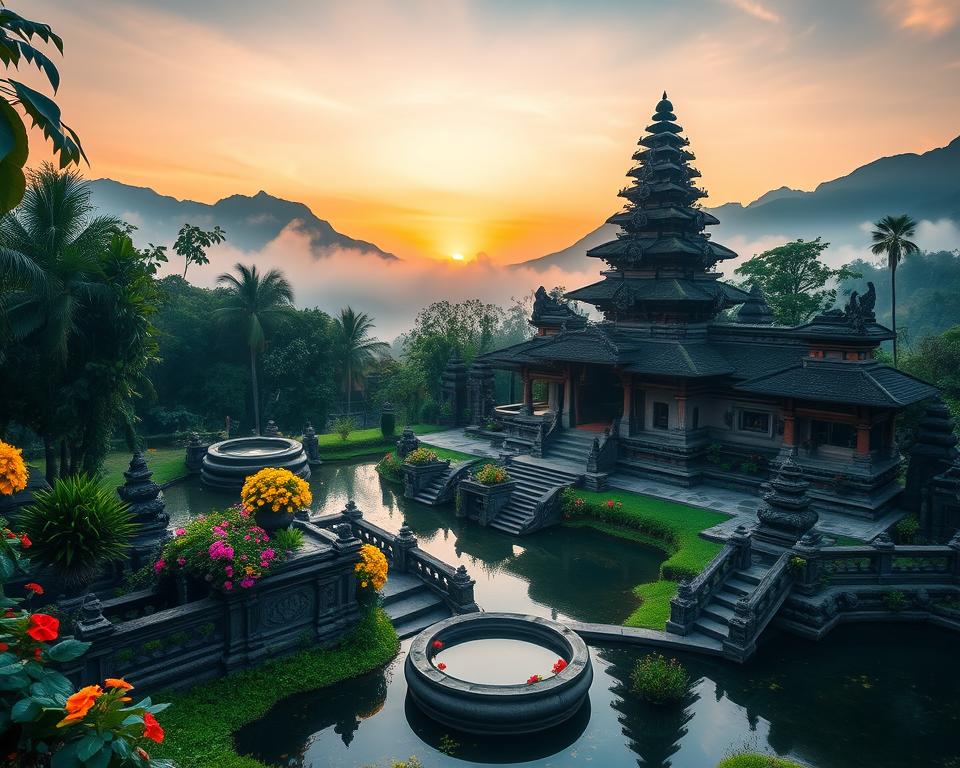
“Temples in Bali are not just physical structures, but living, breathing entities that connect the earthly and divine realms.”
–Nyoman, local Balinese guide
Pura Gunung Kawi Sebatu: A Serene Water Temple
Pura Gunung Kawi Sebatu is a hidden gem near Ubud. It’s a peaceful water temple away from the crowds. It’s different from Pura Tirta Empul, with a calm vibe for those wanting a real Balinese Water Purification Ceremony in the Quiet Ubud Temples.
This temple complex has calm pools, detailed stone carvings, and a peaceful feel. The entrance fee for international visitors is IDR 30,000, about USD 24. It’s open daily from 8:00 AM to 5:00 PM, best visited from April to October4. Parking costs IDR 5,000 for motorbikes and IDR 10,000 for cars4.
The temple’s history and architecture go back to the 11th century. It has 10 shrines, with four on the west and five on the east side of the river5. King Anak Wungsu built it to honor his father and the Warmadewa Dynasty5.
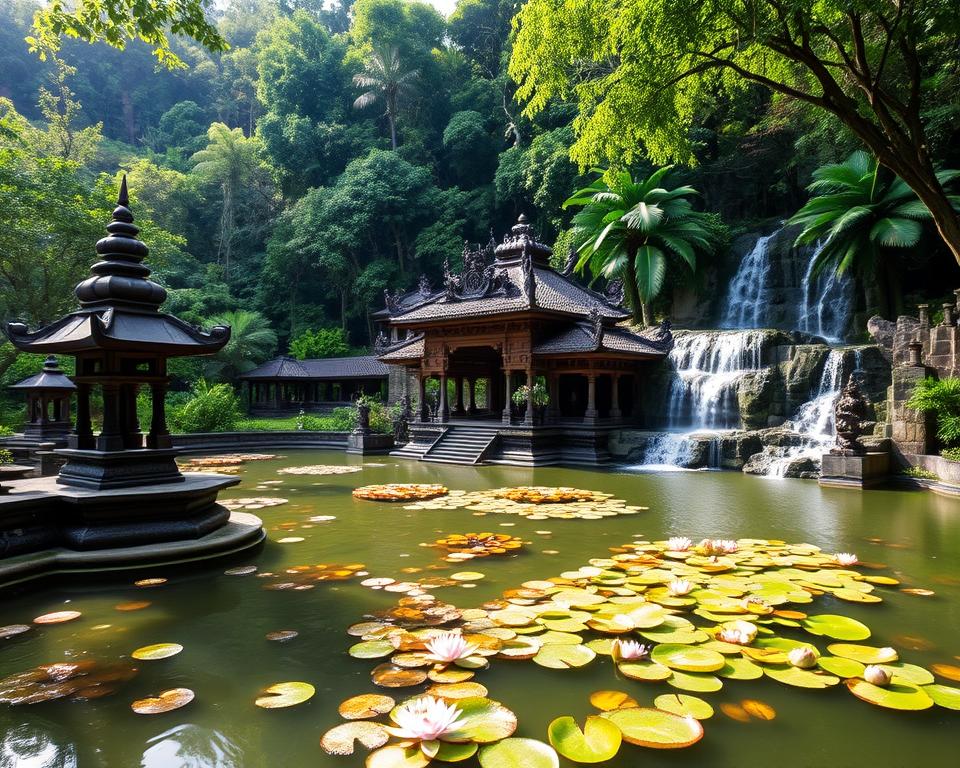
The temple has a calm bathing area with two pools and 10 waterspouts6. You can join the Balinese Water Purification Ceremony here. It’s a spiritual experience that cleanses your mind, body, and soul. The temple’s festival, Purnama Sasih Kasa, is on 19th July, drawing many visitors6.
Pura Gunung Kawi Sebatu is a must-see for a Quiet Ubud Temple experience. It offers a serene setting, rich history, and a chance to join a traditional water ritual. This hidden gem gives a real and unforgettable Balinese cultural experience.
Goa Gajah: The Mystical Elephant Cave
In the heart of Ubud, the Goa Gajah, or Elephant Cave, is a 11th-century Balinese Hindu temple. It invites visitors to explore its history and peaceful meditation spots7. The entrance is marked by a carved demonic face, making it known as “Elephant Cave”8.
History and Architecture of the Elephant Cave
The Goa Gajah Temple complex is from the 9th century and was found again in 19548. The cave has a T-shaped structure with many elements. It has two niches outside and 11 inside the main room9.
The temple grounds have detailed carvings of trees, animals, and a Kala Head sculpture at the entrance. This sculpture means protection and sanctity9.
Exploring the Meditative Spaces
The Goa Gajah Temple is also a place for peaceful meditation and spiritual reflection7. It has a calm holy pond called the Pond of Patirtaan, found in 1954. The pond has statues of angels and showers9.
The temple sits where two rivers meet, the Pangkung River and Petanu River. This spot is believed to have magical energy, making it great for meditation9.
Visiting the Goa Gajah, or Ubud Elephant Cave, is a must for those exploring Ubud’s hidden gems78.
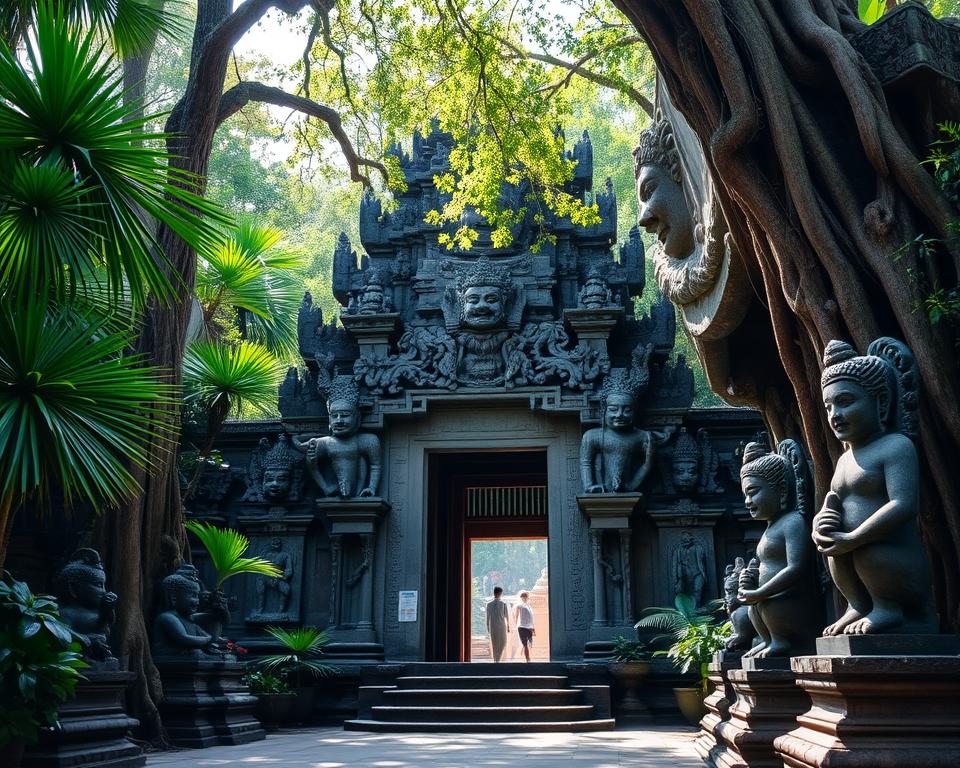
Pura Gunung Lebah: A Hidden Treasure on Campuhan Ridge
Pura Gunung Lebah is hidden at the end of Campuhan Ridge Walk10. It’s an old temple from the 8th century. It’s dedicated to the Batur goddess and has beautiful carvings and a calm courtyard10.
Even though it’s close to tourist spots, it’s often quiet. This lets visitors enjoy the temple’s peaceful vibe. They can also see its stunning 8th-century architecture.
The Campuhan Ridge Walk starts here. It’s a 2-kilometer trail with amazing views11. It’s free and loved by locals and tourists12.
The best times to go are sunrise for peace, afternoon for photos, and sunset for romance10.
Pura Gunung Lebah is a secret spot, often missed by visitors10. It’s a calm temple with detailed carvings and a quiet courtyard. It’s a special place to learn about Balinese culture and architecture11.
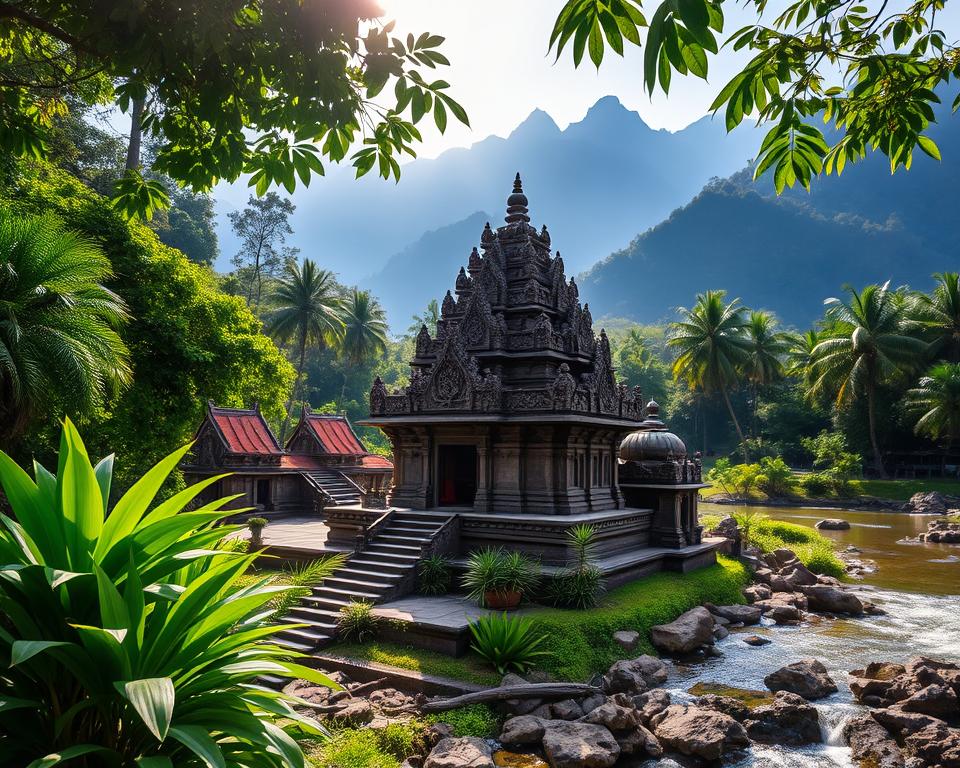
If you want a quiet spot or to explore Ubud’s secrets, visit Pura Gunung Lebah10. It’s close to the Campuhan Ridge Walk and has a rich history. It’s a key spot for any trip to Ubud111012.
Hidden Temples in Ubud
In Ubud, you’ll find hidden temples that show Bali’s deep spiritual roots13. The Samuan Tiga Temple has amazing stonework from the 10th century. The Goa Garba Ruins tell stories of old times. These places let you dive into Ubud’s culture and history.
Samuan Tiga Temple: An Intricate 10th-Century Wonder
The Samuan Tiga Temple is from the 10th century13. It was a special place for the Hindu Trinity. Walking through, you’ll see amazing stonework and stories from old times.
Goa Garba Ruins: Remnants of an Ancient Civilization
Find the Goa Garba Ruins for a peek into Bali’s past14. It’s a place where old stories come alive. The ruins show what life was like long ago.
“The hidden temples of Ubud are a testament to the enduring spirituality of the Balinese people, each one a window into the island’s captivating history.” – Balinese Temple Historian
Exploring Ubud’s temples, you’ll see their beauty and importance1314. They invite you to slow down and enjoy their calm. You’ll learn to love Bali’s spiritual side more.
Discovering Authentic Balinese Villages
Ubud is popular, but there are real Balinese villages to find. They show the island’s old ways of life. You can see the culture and how people live sustainably.
Nyuh Kuning Village: A Window into Local Life
Nyuh Kuning Village is near the Monkey Forest. It’s a real Balinese community. Here, you can see wood carving and farming that’s been around for ages15.
Walk the streets, try local food, and learn about Balinese culture. It’s a special place.
Sibetan Village: The Home of Salak Wine
Sibetan Village is at Mount Agung’s foot. It’s famous for salak wine15. You can help make the wine, getting close to a special tradition.
Try the wine and learn about its history. It shows the Balinese people’s hard work and creativity.
| Village | Highlights |
|---|---|
| Nyuh Kuning Village |
|
| Sibetan Village |
|
These villages let you see real Balinese culture. Meet locals and explore. You’ll love the island’s history and people’s strength.
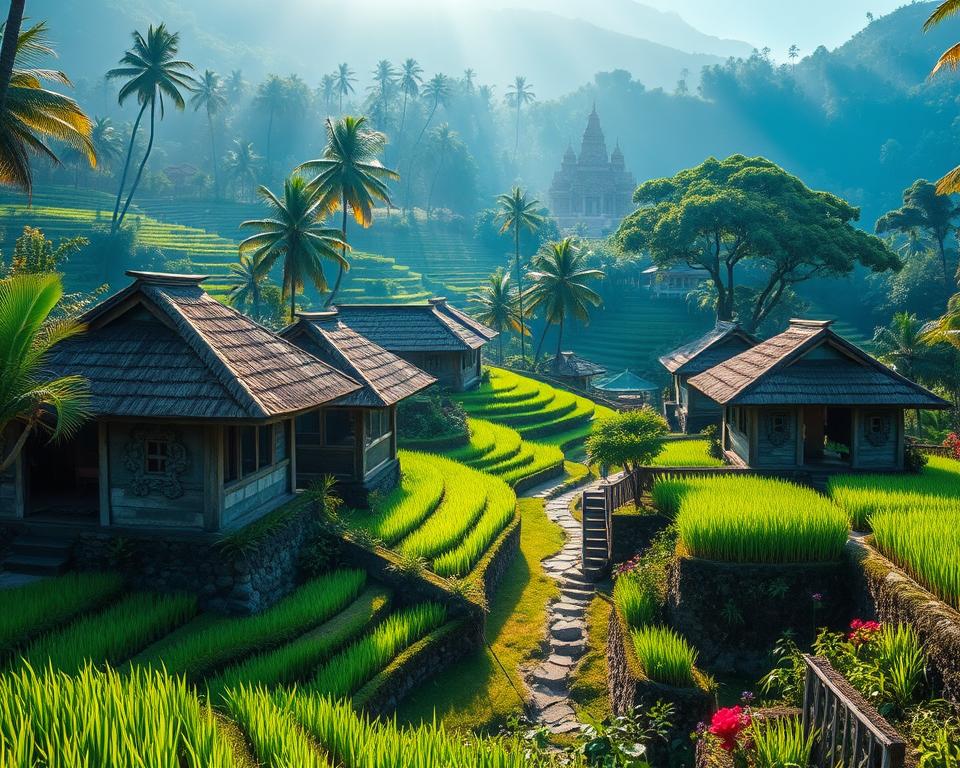
“Visiting these authentic villages is like stepping back in time, where the rhythm of life is dictated by the seasons and the land. It’s a humbling and enriching experience that every traveller to Bali should seek out.”
Nature’s Hidden Gems in Ubud
Ubud is full of beautiful natural spots. These places are peaceful and away from the busy tourist areas. You can find the Kajeng Rice Terraces and the Campuhan Ridge Walk here. They show the amazing beauty of the16 Ubud area.
Kajeng Rice Terraces: A Tranquil Escape
The Kajeng Rice Terraces are less crowded than Tegalalang. They offer a calm and real experience16. You can see green rice fields and watch farmers work.
Walking here, you can take great photos. The sound of water helps you relax and think deeply.
Campuhan Ridge Walk: Scenic Trails and Vistas
The Campuhan Ridge Walk is perfect for nature lovers16. It has beautiful views of hills and valleys. It’s great for a morning walk or a relaxing stroll.
Walking here, you’ll see lots of green and hear the Campuhan River. It’s a quiet place to explore in the16 Ubud area.
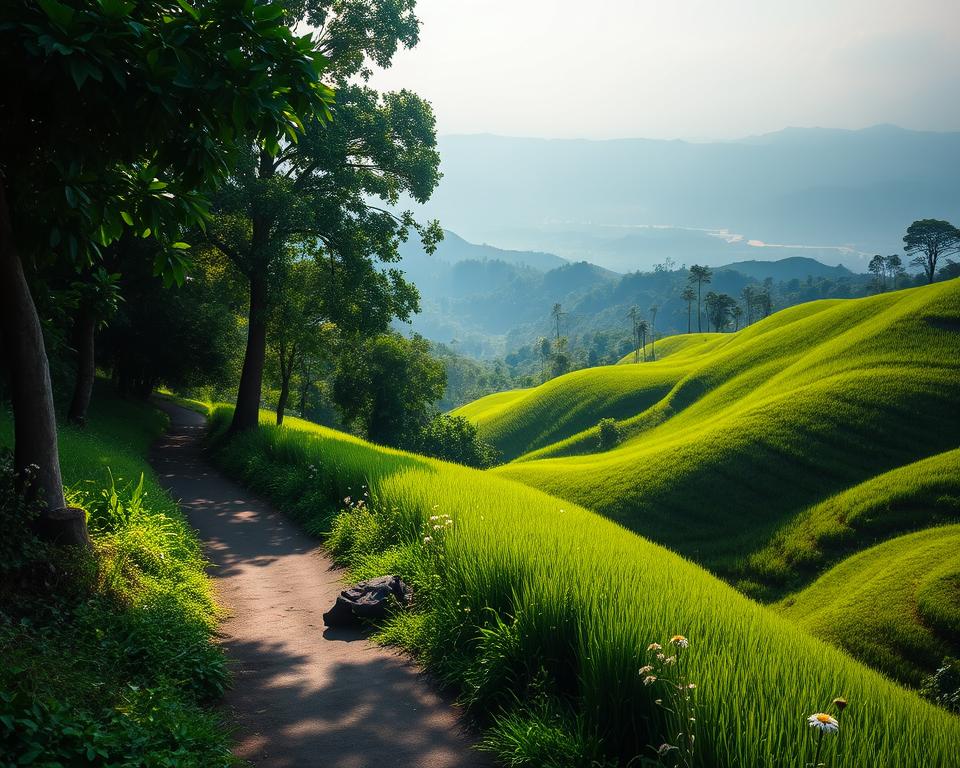
Looking for peace or a scenic walk? Ubud’s16 nature spots are a nice change from busy places. Visit the Kajeng Rice Terraces and the Campuhan Ridge Walk. Nature will refresh you and make you feel good.
Immersive Cultural Experiences
Ubud is the heart of Bali’s culture. It lets visitors dive into the island’s rich heritage. You can try traditional cooking or watch dance performances. Ubud shows the local culture, inviting you to explore more than usual tourist spots17.
Balinese Batik Workshop: Crafting Intricate Designs
Don’t miss the Balinese batik workshop in Ubud. Here, you learn to make beautiful textiles18. Skilled artisans teach you how to use wax and dyes to make your own batik. It’s a way to connect with Bali’s artistic past18.
Traditional Farming Lessons: Sustainable Practices
Explore Ubud’s sustainable farming practices. At Mupu Rice Terrace, you can help with farming. It shows the hard work and creativity in growing Bali’s landscapes18.
These experiences in Ubud give you a peek into local life. They help you understand and respect Bali’s heritage and traditions18. Whether making batik or learning farming, these moments will change your view of Bali17.
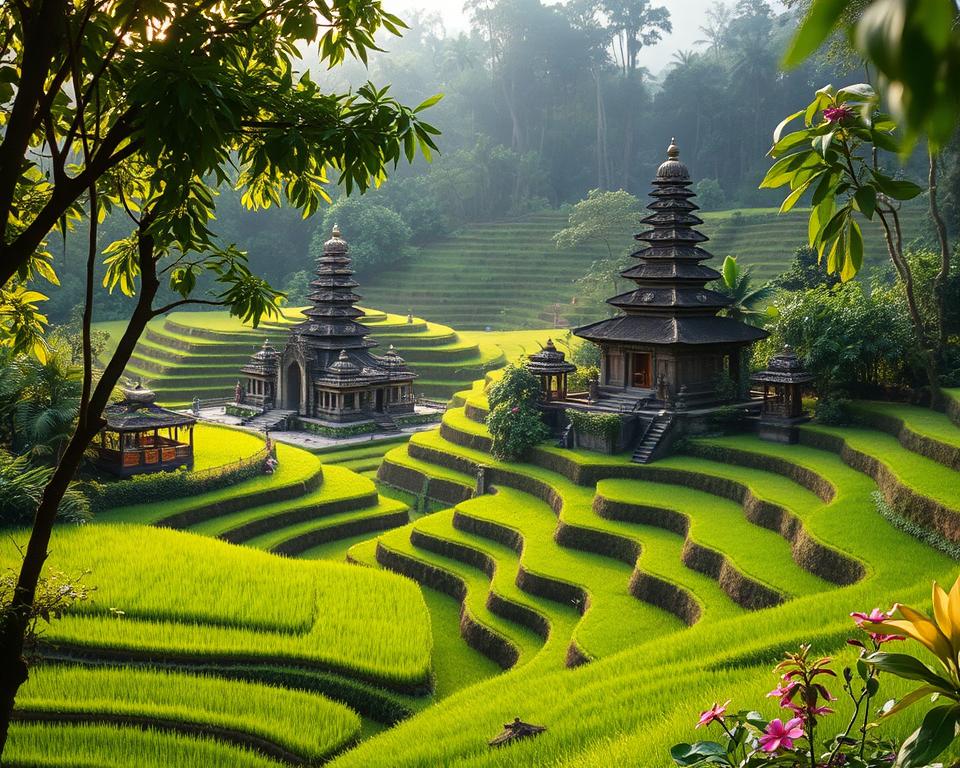
Conclusion
As you start your journey in Ubud, you’ll dive into Bali’s spiritual and artistic heart. You’ll see sacred springs like Tirta Empul19 and the magical Elephant Cave19. These places let you connect with Bali’s traditions and beliefs.
Explore places like Pura Taman Ayun19 and Gunung Kawi Sebatu19. Each spot shows how much the Balinese value nature, spirit, and life.
Ubud’s culture is also vibrant20. You can watch dances, see art, and live like a local. Visit the Tegallalang Rice Terraces20 and the Ubud Monkey Forest20. You’ll see the island’s beauty and culture.
By seeing these hidden spots, you learn about the Balinese people. You’ll understand Ubud Hidden Temples, Balinese Culture, and Visiting Ubud better.
When you leave Ubud, you’ll love the island more. The memories of temples and culture will inspire you. They will make you see Balinese Culture and nature’s bond in a new way.
So, go find Ubud’s hidden treasures. Let them change your view of this amazing place.
FAQ
What is the cultural and spiritual significance of Ubud in Bali?
Ubud is the heart of Bali’s culture and spirit. It’s known for its valleys, rice fields, and temples. Temples are key in Balinese Hindu life. They are places for worship, meditation, and community.
What are some of the hidden temples in Ubud that visitors can explore?
Ubud has hidden temples like Pura Gunung Kawi Sebatu. It’s a calm water temple. Also, there’s Goa Gajah, or the Elephant Cave. And Pura Gunung Lebah, hidden at the end of the Campuhan Ridge Walk.
Why are the hidden temples in Ubud worth visiting?
Visiting these temples lets you experience peace and connect with Bali’s traditions. You’ll see real Balinese rituals and culture, away from tourists.
What other cultural experiences can visitors explore in the Ubud area?
You can try Balinese batik art and learn about green farming. Also, discover salak (snake fruit) wine in Sibetan Village.
What are some of the natural attractions and hidden gems in the Ubud region?
Ubud has beautiful nature like the Kajeng Rice Terraces and the Campuhan Ridge Walk. They offer a quiet and real experience, away from the crowds.
Source Links
- https://finnsbeachclub.com/guides/best-temples-in-ubud-bali/
- https://www.tanahgajahubud.com/press/a-deep-dive-into-the-art-of-discovery-experience-in-ubud
- https://medium.com/@breedenchae/5-best-ubud-attractions-private-day-tours-uncover-balis-hidden-gems-5366897a0ce0
- https://balicheapesttours.com/gunung-kawi-sebatu-temple.html
- https://www.indonesia.travel/gb/en/destinations/bali-nusa-tenggara/bali/gunung-kawi-temple.html
- https://discoveryourindonesia.com/complete-guide-gunung-kawi-sebatu/
- https://www.balicheapesttours.com/goa-gajah-temple.html
- https://villaamrita.com/elephant-cave-goa-gajah-ubud/
- https://balisnorkelingtour.com/goa-gajah-temple-bali/
- https://www.balicheapesttours.com/campuhan-ridge-walk-ubud.html
- https://traveltriangle.com/blog/campuhan-ridge-walk/
- https://www.saltinourhair.com/bali/things-to-do-ubud/
- https://www.raftingbali.net/saraswati-temple-ubud/
- https://happinessontheway.com/hidden-gems-in-ubud/
- https://www.worldnomads.com/explore/southeast-asia/indonesia/travelers-guide-to-ubud-bali
- https://www.traveloka.com/en-sg/explore/destination/ubud-hidden-gems-acc/363778
- https://baliventur.com/day-trips-to-ubud/
- https://theculturetrip.com/asia/indonesia/bali/articles/10-incredible-cultural-experiences-in-ubud-bali
- https://bali-home-immo.com/blog/bali-s-hidden-water-temples
- https://travellingwithsinemika.dk/?p=180